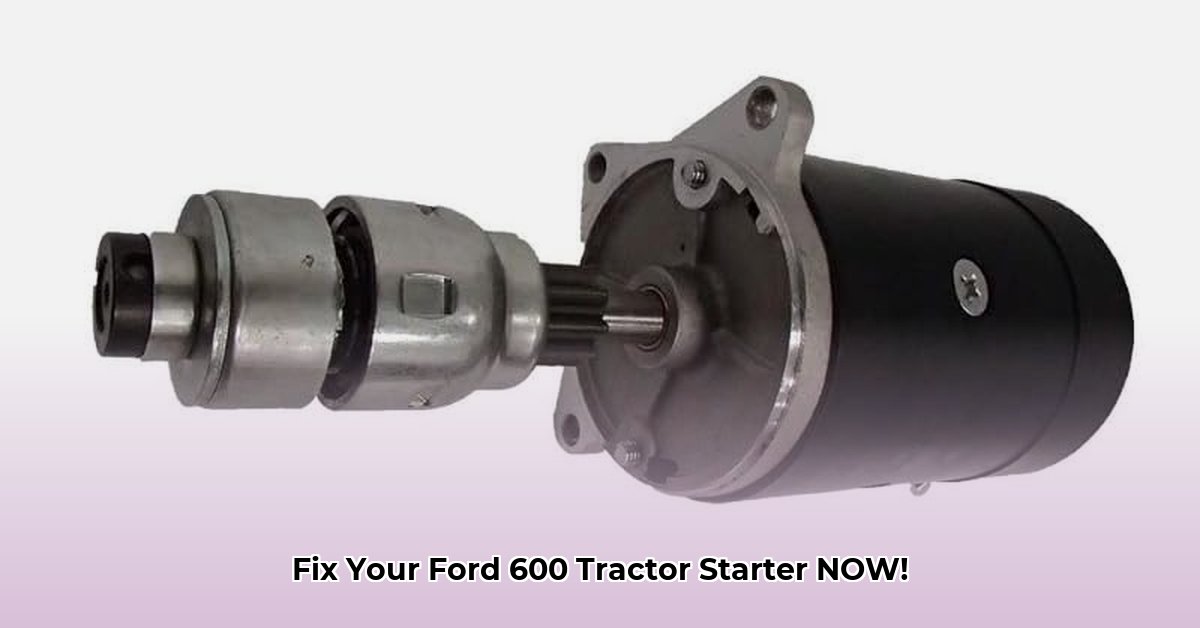
Troubleshooting Common Ford 600 Tractor Starter Problems
A Ford 600 tractor refusing to start can be incredibly frustrating, but often the culprit is a malfunctioning starter motor. This guide provides a step-by-step approach to diagnosing and resolving common starter issues, from simple checks to complete replacements. Before starting any repairs, always consult your owner's manual for model-specific information and diagrams. For more detailed diagrams, check out this helpful resource: Ford 600 Starter Diagrams.
Common Symptoms and Potential Causes:
Slow Cranking: This often indicates a weak battery, corroded battery terminals, or a failing starter motor. Check battery voltage first. A low voltage reading points to a battery issue; otherwise, the starter may be the problem.
Clicking Noise: A rapid clicking sound usually means insufficient power to engage the starter. This points to a weak battery, corroded connections, or a faulty starter solenoid (the electromagnetic switch activating the starter motor).
Complete Silence: No sound at all suggests a dead battery, a malfunctioning starter motor, a problem with the ignition switch, or a break in the wiring harness. Systematic electrical circuit tracing is needed here.
Are you ready to tackle this? Let's get started!
Testing the Ford 600 Tractor Starter
Before purchasing a replacement, verify the starter motor is indeed faulty. You'll need a multimeter (a device measuring voltage, current, and resistance) for these tests.
Safety First: Always disconnect the negative battery terminal before beginning any electrical work. This prevents accidental shocks and short circuits.
Steps:
- Access the Starter: Locate the starter motor (usually attached to the engine block). You may need to remove components for easier access. Consult your owner's manual for precise location and removal instructions.
- Test the Solenoid: Use your multimeter to check the solenoid's continuity and voltage. Refer to online resources and diagrams specific to your Ford 600 tractor model for testing point locations.
- Test the Starter Motor: This requires more caution. You may need to temporarily bypass the solenoid (following specific online instructions for your model). Apply power directly to the starter motor's terminals using the multimeter. If it spins, the motor is likely fine; the solenoid is the likely culprit. If it doesn't spin, the starter motor needs replacing.
Replacing the Ford 600 Tractor Starter
If testing confirms a faulty starter, replacement is the next step.
Tools Required: Wrenches (of appropriate sizes), sockets, a possible puller (depending on your model), and penetrating oil (to loosen stubborn bolts).
Steps:
- Disconnect the Battery: Always disconnect the negative terminal first!
- Remove the Old Starter: Carefully remove the bolts securing the starter motor to the engine block, again referencing your owner's manual for precise locations and removal procedures.
- Install the New Starter: Mount the new starter and carefully reconnect the wiring. Use a wiring diagram to ensure correct connections. Incorrect wiring can damage the tractor's electrical system.
- Reconnect the Battery: Once secure, cautiously reconnect the negative battery terminal.
- Test: Attempt to start the tractor.
Choosing a Replacement Starter: OEM vs. Aftermarket
You have two choices for replacement starters:
- OEM (Original Equipment Manufacturer): Offers reliable quality and a guaranteed fit, but comes at a higher price.
- Aftermarket: Less expensive, but quality can vary significantly. Thoroughly research reviews before purchasing an aftermarket starter.
Maintaining Your Ford 600 Tractor Starter
Preventative maintenance extends the life of your starter.
- Clean Battery Terminals: Regularly clean terminals with a wire brush and a baking soda solution to prevent corrosion, a major cause of starting problems.
- Inspect Wiring: Regularly check for damage or loose connections in the wiring harness leading to the starter.
- Battery Care: Keep the battery fully charged using a battery charger to minimize stress on the starter.
Safety Precautions When Working on Your Ford 600 Tractor
Safety is paramount when dealing with electrical components and heavy machinery.
- Disconnect the Battery: Always disconnect the negative terminal before working on any electrical components.
- Personal Protective Equipment (PPE): Wear safety glasses and gloves to protect against sharp edges or flying debris.
- Professional Help: If unsure about any step, consult a qualified mechanic.
Remember to consult your owner's manual for detailed instructions and diagrams specific to your Ford 600 tractor model. This guide provides general information; model-specific procedures may vary.